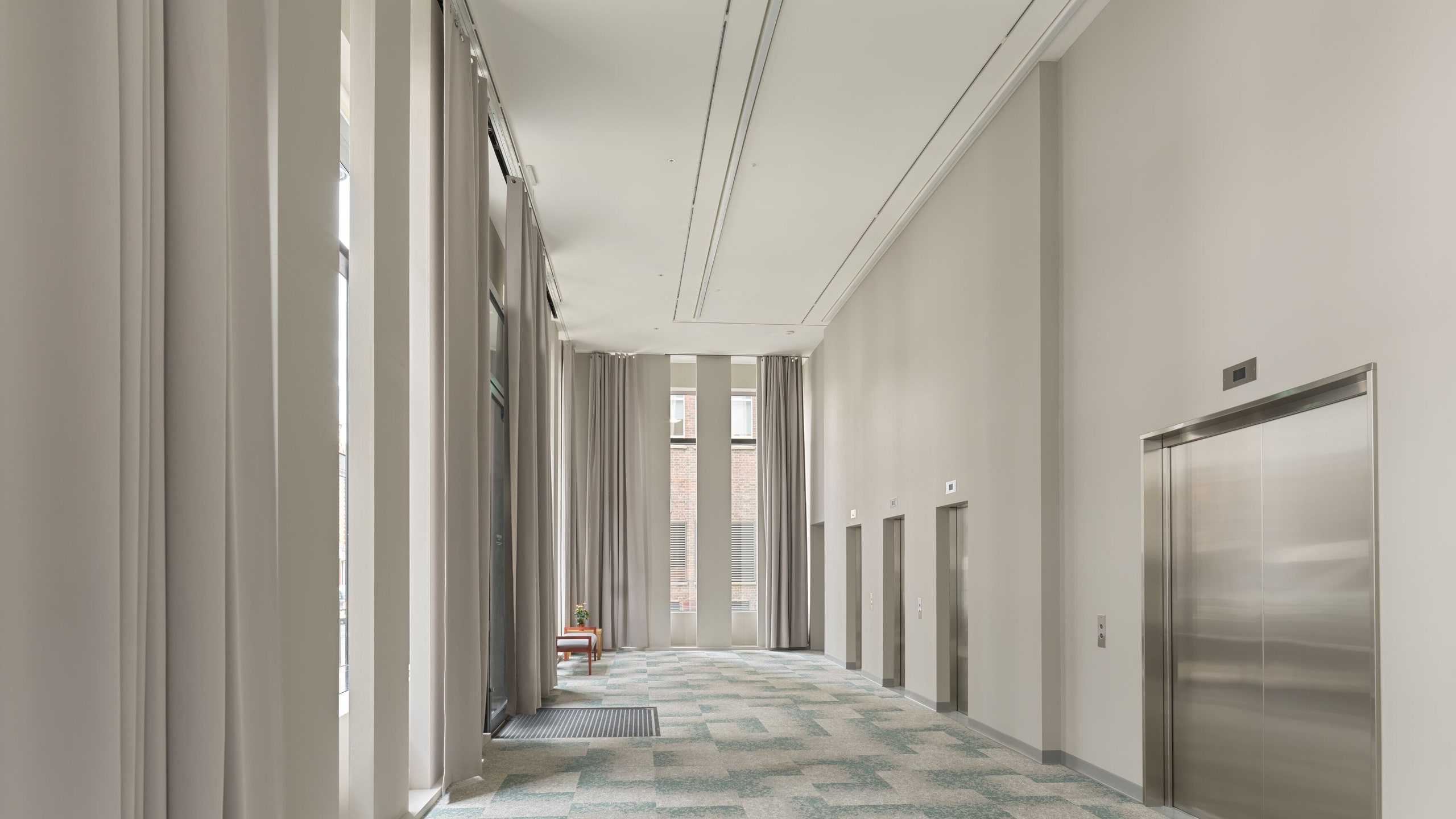The teenaged Avery Singer lived two blocks from the World Trade Center in Manhattan and was home alone on the morning of 11 September 2001. She heard the plane, followed by what felt like an earthquake, and from her Tribeca window, she saw the north tower of the World Trade Center in flames. Later, she found herself watching people fall, wondering if they’d chosen to jump. She evacuated downtown, and that night, her family slept in the projection booth at Moma, where her father worked. They returned home six weeks later to a different world.
People walking by on London’s Savile Row may not know it, but the exhibition starts on the street. A fake hoarding has been erected between Hauser & Wirth’s two neighbouring spaces, depicting an office in disarray. Stepping into the gallery is to step back to 10 September 2001, which was, coincidentally, Avery’s 14th birthday.
As if set in aspic, the London gallery has been transformed into a faithful recreation of Minoru Yamasaki’s World Trade Center lobby, with lifts lining one wall, ready to ping open at any moment to reveal a bustle of business people, en route from their desks in the sky. During the press preview, a member of the public enters from outside and unwittingly tries to access the lift to the real-life offices above the gallery, and is politely moved along, a tribute to how accurately Avery has recreated the office lobby. There’s nostalgia baked into the carpets (which are 1990s-inspired and sepia-toned, swirling, galactic and pixelated.) Even the plug sockets have been changed to reflect the American standard as it was in the late 20th century.
It is here, or in an adapted recreation of that space, that we find a 36-year-old Avery today, caught in the gaze of enormous portraits of the ‘famous’ faces of 9/11, alongside studies of a crack pipe, a police car and a pair of viewing binoculars peering down from the Window on the World restaurant. We, in turn, are witnessing Avery’s memories swirl up from the carpets.
It’s an immersive installation in which Avery’s large portraits find a home. They are made using a free-to-download architectural programming tool called SketchUp and painstakingly layered over a number of months, lending them a gamified, hyperrealistic quality, as if they are characters in an apocalypse-survival video game. Each is strung up on metal poles that stretch from floor to ceiling, echoing the steel columns at the heart of each tower, columns that were irrevocably severed and twisted by the impact of the jets.
The portraits are what the artist calls ‘deepfakes’ and depict Rachel Uchitel, Marcy Borders and Stan Honda. Days after the attacks, pictures of Rachel Uchitel sobbing while clutching a photo of her missing fiancé Andy O’Grady went viral, landing on the front page of the New York Post. They went on to become one of a few heart-wrenching poster children of tragedy; impossible to look at, impossible to look away from. Marcy Borders is the figure pictured in the unforgettable ‘dust lady’ photograph, and Stan Honda, the one who took it. What unites many of these very real people whose stories have become intrinsically wrapped up and warped by the events of that day, is their common challenges with addiction post-9/11, which Avery herself shares. ‘I really felt a poignant connection with [the two women featured in the exhibition] because of their struggles with addiction after surviving this traumatic experience,’ Avery shares. ‘I certainly have that problem, and have for many years.’ It’s the most explicitly autobiographical this increasingly in-demand artist has ever been in her work.
On the floor, strips of scattered paper stick to our shoes, reminiscent of the sheets and sheets of it that burst from the towers; reflections of which can be glimpsed by staring into Rachel Uchitel’s eyes. Flickering computer screens can be seen in Marcy Borders’s.
The exhibition continues as we tunnel deeper into the ‘tower’, arriving in a claustrophobic room; a representation of a windowless World Trade Center office that her mother had worked in, and in which Avery had spent a lot of time during her childhood. It is this room that Avery comes face to face with herself – or at least a deepfake version. Opposite, depicting a linear time through stills, there’s a figure falling through space and landing safely on her back. ‘I was honestly not thinking about falling people dying,’ Avery clarifies. ‘I was thinking about a state of mind that you are in when you’ve gone through something really difficult psychologically: it can feel like you’re falling. To me that’s like a metaphor of spiritual space. So I decided to title the show after that.’ To view it is an uncomfortable experience, one of viewing works that stare trauma in the face and beg us not to look away.
‘Free Fall’ is at Hauser & Wirth London until 22 December 2023. Visit hauserwirth.com
